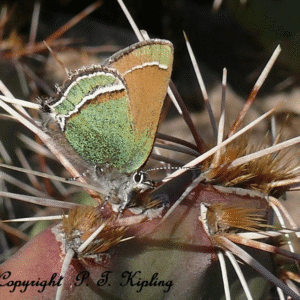The Juniper hairstreak, otherwise known as the Olive hairstreak, (Callophrys gryneus) is a native North American butterfly. This tiny butterfly is easily recognized by its bright green wings with orange and white stripes on the underside of the wings. With a wingspan of just about 1 inch and a body length of approximately 0.7 inches, this insect is truly a miniature marvel.

This non-migratory butterfly has a habitat range spanning the entire United States and extending into southwestern Canada. Several subspecies exist, each adapted to the specific environment it inhabits based on the region it lives. One unique subspecies is the Sandia hairstreak (Callophrys mcfarlandi) which is especially suited to the environment around the Sandia Mountains. In fact, this beautiful butterfly is New Mexico’s own State Butterfly!
The Juniper hairstreak is closely associated with cedars and juniper trees which serve as its host plants. In western regions, it prefers Rocky Mountain juniper (Juniperus scopulorum), while in the east, it commonly uses the Eastern red cedar (Juniperus virginana). It may also utilize cypress trees. Females lay their pale green and white eggs on the tips of the juniper needles. When the vivid green larvae hatch, they display a faint mid-dorsal stripe that begins at the thorax and runs down the abdomen. These caterpillars feed on fresh juniper leaves until they are ready to form a chrysalis.
Chrysalises of western populations tend to be darker brown, allowing them to blend in with the bark of junipers as they overwinter. In early April to mid-May, the adult butterflies emerge and begin searching for nectar sources. They are commonly drawn to blooming flowers such as milkweed, geraniums, and coneflowers. Juniper hairstreaks will most likely be seen near its tasty floral nectar sources, and probably not far from its host plant sources, juniper trees.

Juniper hairstreaks contribute to their ecosystems as pollinators of native flowers and as a food source for other animals. They also serve as a valuable indicator species – since they rely on junipers, their presence can signal the health of local juniper populations. Beyond their ecological role, these butterflies offer a chance to connect with nature. Their vivid colors and small size make them a delight to spot and observe up close.
Keep an eye out for Juniper hairstreaks around blooming flowers and juniper trees. Though tiny, they are a beautiful and important part of the natural world.
Text by Simone Schmidt
Simone is a Wildlife Biologist at Stantec Consulting, a butterfly-plant network specialist, and outdoor enthusiast!
References:
